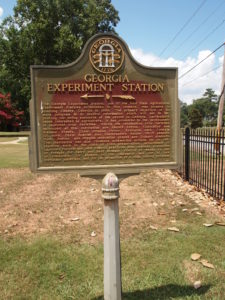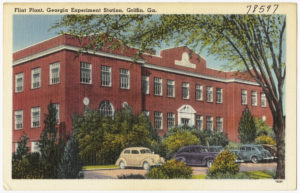In honor of the 2016-2017 Georgia History Festival, “A State of Innovation,” the December #MarkerMonday posts will focus on Charles Holmes Herty, naval stores, and agricultural innovation in Georgia.
 This week’s #Marker Monday highlights agricultural developments in Georgia. The Georgia Experiment Station, located in Griffin, Georgia, was created in 1888 as part of a national effort to establish agricultural research facilities. Early scientists at the Station developed new techniques for farming, such as the deep furrow method, and they solved many problems associated with Georgia’s crops. As a result, the state’s agricultural business improved. Griffin scientists developed feed for dairy and beef cattle, and improved crop varieties such as Empire Cotton, Chancellor and Bledsoe wheats, Dixie crimson clover, Arlington oats, Georgia 101 corn, Dixie Spanish and Southeastern Runner 56-15 peanuts, Hunt, Dulcet, and Higgins muscadine grapes, and Truhart pimiento.
This week’s #Marker Monday highlights agricultural developments in Georgia. The Georgia Experiment Station, located in Griffin, Georgia, was created in 1888 as part of a national effort to establish agricultural research facilities. Early scientists at the Station developed new techniques for farming, such as the deep furrow method, and they solved many problems associated with Georgia’s crops. As a result, the state’s agricultural business improved. Griffin scientists developed feed for dairy and beef cattle, and improved crop varieties such as Empire Cotton, Chancellor and Bledsoe wheats, Dixie crimson clover, Arlington oats, Georgia 101 corn, Dixie Spanish and Southeastern Runner 56-15 peanuts, Hunt, Dulcet, and Higgins muscadine grapes, and Truhart pimiento.
Currently, the Georgia Experiment Station focuses on five major areas of research: crop and pest management, food safety and quality, environment and natural resources, urban agriculture, and applied pest genetics. These categories work together to provide better living conditions for people across the state. Station scientists work to develop pesticides that are not only effective, but are also environmentally safe. Proper pest management contributes to the safety and quality of Georgia’s food. Harmful insects, disease, and drought are threats to our food supply, so station researchers are continuously working towards developing new breeds of plants that are resistant to these problems. These scientists were, and continue to be, innovators in Georgia. Since the Station opened, dedicated researchers have worked to supply and maintain the states agriculture.
Top Image Courtesy of David Seibert
Explore the links below to learn more about the Georgia Experiment Station.

